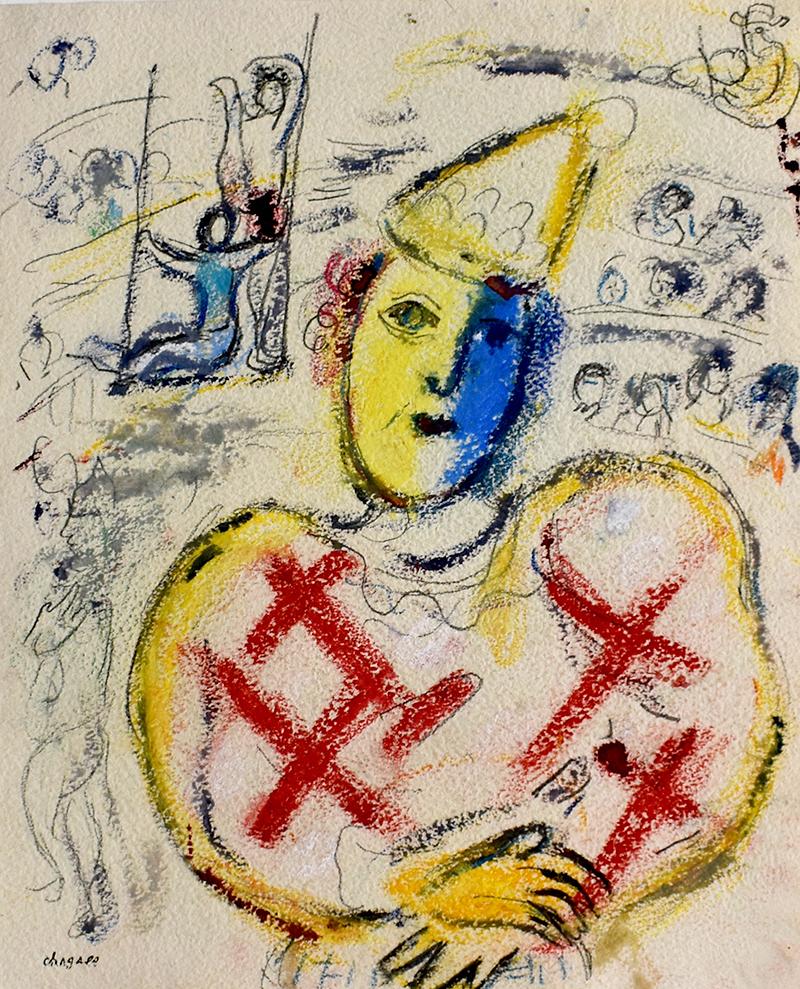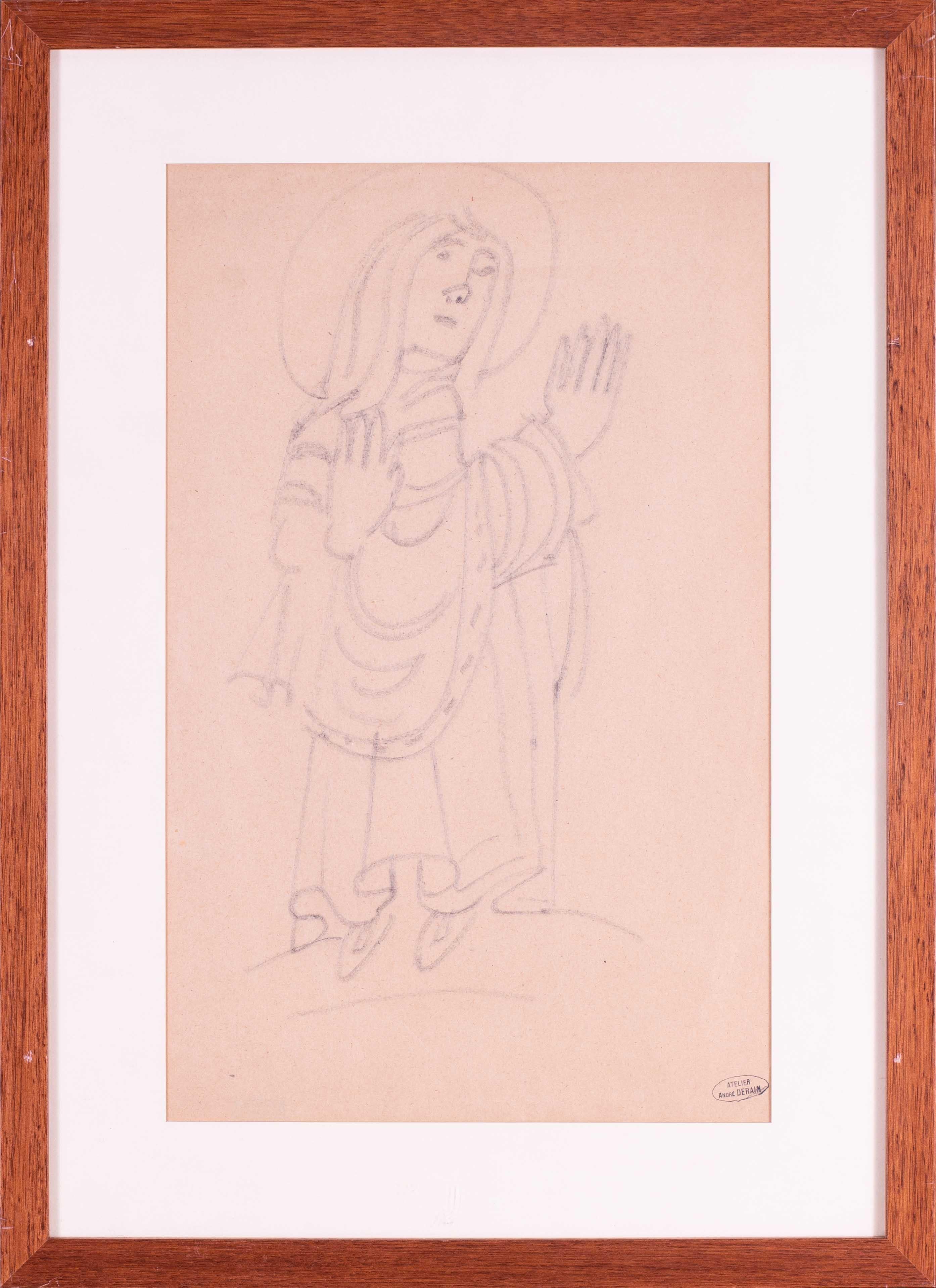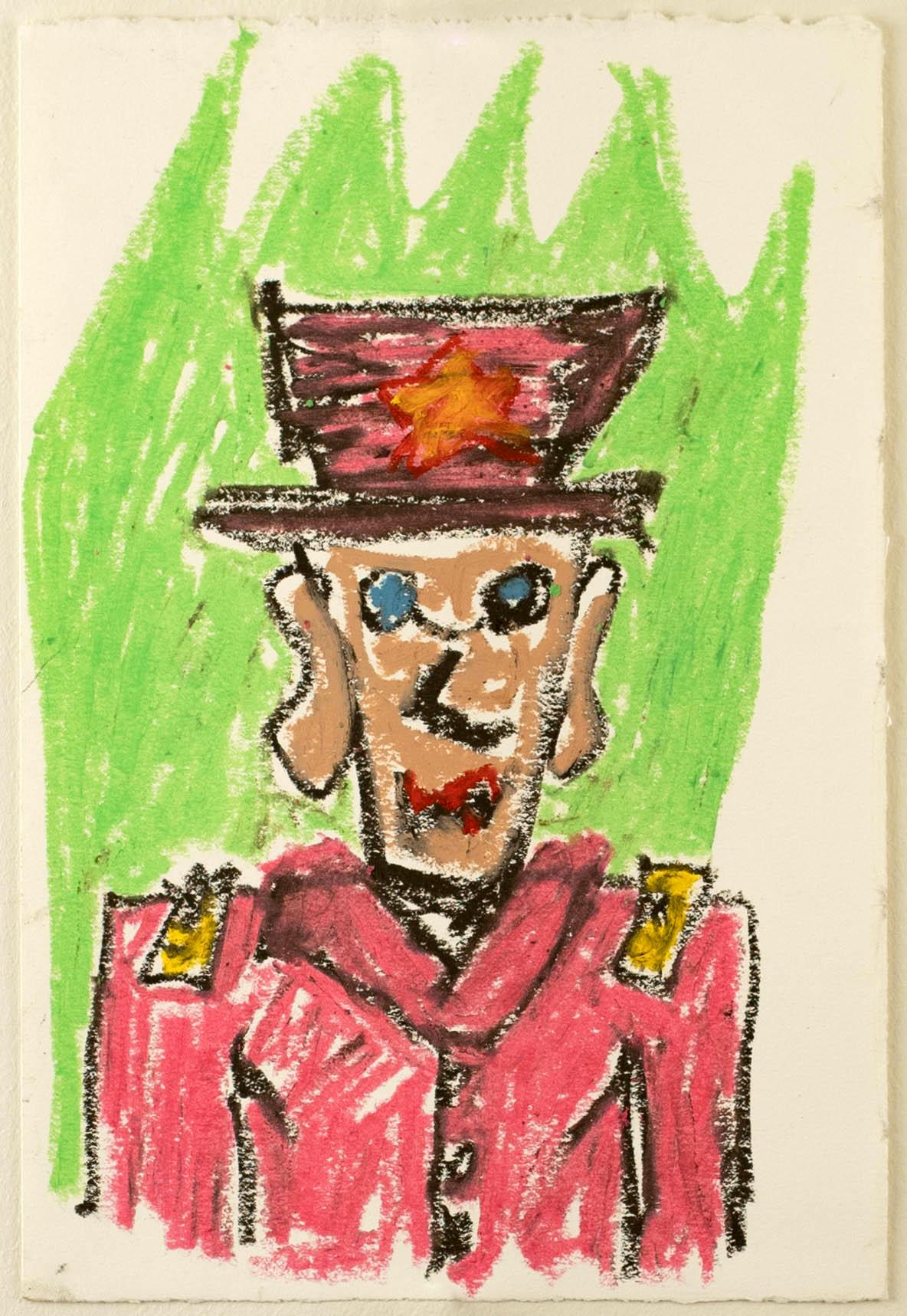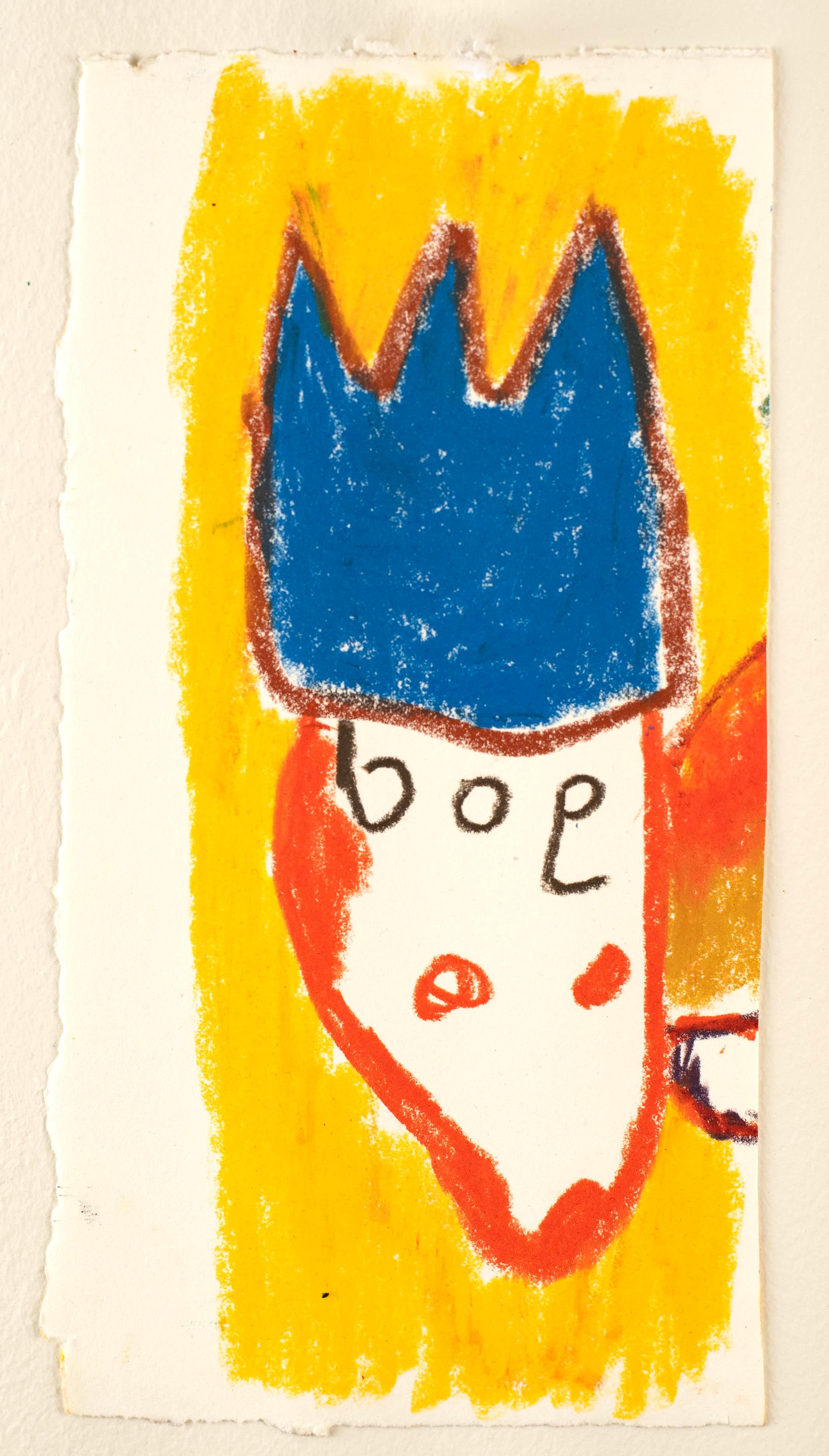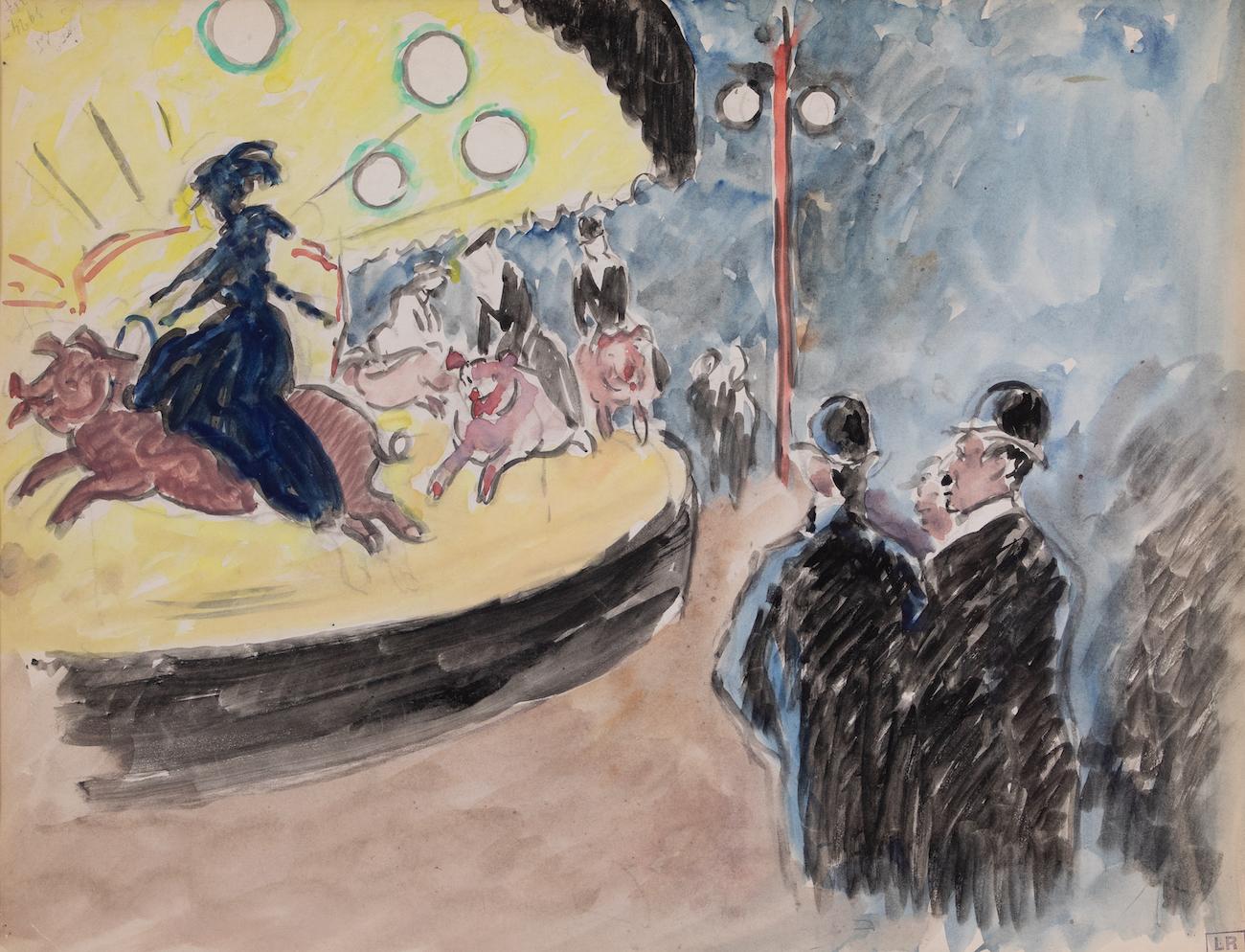Items Similar to Men Working on Kibbutz Palestine, Israeli Judaica Pastel Drawing
Want more images or videos?
Request additional images or videos from the seller
1 of 8
Eliyahu SigardMen Working on Kibbutz Palestine, Israeli Judaica Pastel Drawingc.1940s
c.1940s
About the Item
From The British mandate Pre State of Israel Palestine Period.
Eliahu Sigad (Eliyahu Sigard), painter, born 1901, Lithuania. Founder of Israeli Painters' Association. Educated in Europe. Prizes in Israel, Exhibitions in Israel and various countries of the world. Died 1975.
Education
Riga, architecture and drawing
Colarossi Academy, Paris, France
1930 Grande Chaumiere, Paris, France
Awards And Prizes
1938 Dizengoff Prize
1945-46, Dizengoff Prize
1945 Ramat Gan Prize
1946 Ramat Gan Prize
1956 Exhibition of the Landscape of Tiberias, First prize
1958 Tenth National Israeli Exhibition, Ramat Gan.
In the late 1920s artists from Ereẓ Israel began flocking to Paris; this was accompanied by a tendency to abandon the former modernistic manifestations and folk-loristic character and by an intensified desire to root art in an established artistic tradition, all the more so since France in those years was marked by the trend of reverting to traditional artistic values. Paris offered the Ereẓ Israel artists a wide range of choices. There was the French landscape tradition of the 19th century (Corot, Courbet) and various impressionist and post-impressionist trends (Cézanne, the "intimist" artists). The Jewish School of Paris artists (Soutine, Mintchine, Kremegne, Menkès) offered an expressionism based on a dark palette with the paint laid thickly as an element conveying atmosphere and feeling. Artists such as Haim *Atar (Apteker; 1902–1953), Mokady, Frenkel, and Moshe Castel were shaped by the extreme expressionist manifestations, as represented by Soutine. Others, such as Shemi, Haim Gliksberg (1904–1970), Avigdor *Stematsky (1908–1989), Eliahu Sigad (Sigard; 1909–1975), exhibit a more moderate expressionism together with post-impressionist influences.
- Creator:Eliyahu Sigard (1901 - 1972, Israeli, Lithuanian)
- Creation Year:c.1940s
- Dimensions:Height: 15.25 in (38.74 cm)Width: 19.25 in (48.9 cm)
- Medium:
- Movement & Style:
- Period:
- Condition:has not been examined out of frame. there appears to be an old repaired tear to piece.
- Gallery Location:Surfside, FL
- Reference Number:1stDibs: LU38213031382
About the Seller
4.9
Platinum Seller
These expertly vetted sellers are 1stDibs' most experienced sellers and are rated highest by our customers.
Established in 1995
1stDibs seller since 2014
1,543 sales on 1stDibs
Typical response time: 1 hour
- ShippingRetrieving quote...Ships From: Surfside, FL
- Return PolicyA return for this item may be initiated within 3 days of delivery.
More From This SellerView All
- Surrealist fantasy Watercolor Painting Viennese ExpressionistBy Heimrad PremLocated in Surfside, FLHeimrad Prem (1934 – 1978) was a German painter born in Roding, Oberpfalz. From 1949–1952 he studied decorative painting at Schwandorf and then studied painting with Josef Oberberger...Category
1970s Fauvist Figurative Drawings and Watercolors
MaterialsWatercolor
- Expressionist Color Drawing Cobalt Glass Vintage Frame Modernist Ben Zion WPABy Ben-Zion WeinmanLocated in Surfside, FLExpressionist ink and pastel crayon drawing of flowers in vase. Framed in a vintage cobalt blue glass original frame Hand signed and dated Framed it measures 13.5 X 10.5 The actual paper is 7.5 X 5.5 Born in 1897, Ben-Zion Weinman celebrated his European Jewish heritage in his visual works as a sculptor, painter, and printmaker. Influenced by Spinoza, Knut Hamsun, and Wladyslaw Reymont, as well as Hebrew literature, Ben-Zion wrote poetry and essays that, like his visual work, attempt to reveal the deep “connection between man and the divine, and between man and earth.” An emigrant from the Ukraine, he came to the US in 1920. He wrote fairy tales and poems in Hebrew under the name Benzion Weinman, but when he began painting he dropped his last name and hyphenated his first, saying an artist needed only one name. Ben-Zion was a founding member of “The Ten: An Independent Group” The Ten” a 1930’s avant-garde group, Painted on anything handy. Ben-Zion often used cabinet doors (panels) in his work. Other members of group included Ilya Bolotowsky, Lee Gatch, Adolph Gottlieb, Louis Harris, Yankel Kufeld, Marcus Rothkowitz (later known as Mark Rothko), Louis Schanker, and Joseph Solman. The Art of “The Ten” was generally described as expressionist, as this style offered the best link between modernism and social art. Their exhibition at the Mercury Gallery in New York held at the same time as the Whitney Annual Exhibition of Contemporary American Painting, included a manifesto concentrating on aesthetic questions and criticisms of the conservative definition of modern art imposed by the Whitney. Ben-Zion’s work was quickly noticed. The New York Sun said he painted “furiously” and called him “the farthest along of the lot.” And the triptych, “The Glory of War,” was described by Art News as “resounding.” By 1939, The Ten disbanded because most of the members found individual galleries to represent their work. Ben-Zion had his first one-man show at the Artist’s Gallery in Greenwich Village and J.B. Neumann, the highly esteemed European art dealer who introduced Paul Klee, (among others) to America, purchased several of Ben-Zion’s drawings. Curt Valentin, another well-known dealer, exhibited groups of his drawings and undertook the printing of four portfolios of etchings, each composed of Ben-Zion’s biblical themes. He worked as a WPA artist. Ben-Zion’s work is represented in many museums throughout the country including the Metropolitan, the Whitney, and the Museum of Modern Art in New York, the Art Institute of Chicago, the Philadelphia Museum of Art and the Phillips Collection, Washington. The Jewish Museum in New York opened in 1948 with a Ben-Zion exhibition. Ben-Zion consistently threaded certain subject matter—nature, still life, the human figure, the Hebrew Bible, and the Jewish people—into his work throughout his life. "In all his work a profound human feeling remains. Sea and sky, even sheaves of wheat acquire a monolithic beauty and simplicity which delineates the transient as a reflection of the eternal. This sensitive inter- mingling of the physical and metaphysical is one of the most enduring features of Ben-Zion's works." (Excerpt from Stephen Kayser, “Biblical Paintings,” The Jewish Museum Catalogue, 1952). Mystical Imprints: Marc Chagall, Ben-Zion, and Ben Shahn presents the print work of three prominent 20th century Jewish artists born in the Russian Empire. Among these seventy pieces are etchings and lithographs from Chagall’s Bible series...Category
1950s Expressionist Still-life Drawings and Watercolors
MaterialsPaper, Oil Crayon, Pastel, Ink
- Expressionist Ink, Pastel, Crayon Drawing Jewish American Modernist Ben Zion WPABy Ben-Zion WeinmanLocated in Surfside, FLExpressionist ink and pastel crayon drawing of beans (carobs, flowers?) in pods Hand signed. Born in 1897, Ben-Zion Weinman celebrated his European Jewish heritage in his visual works as a sculptor, painter, and printmaker. Influenced by Spinoza, Knut Hamsun, and Wladyslaw Reymont, as well as Hebrew literature, Ben-Zion wrote poetry and essays that, like his visual work, attempt to reveal the deep “connection between man and the divine, and between man and earth.” An emigrant from the Ukraine, he came to the US in 1920. He wrote fairy tales and poems in Hebrew under the name Benzion Weinman, but when he began painting he dropped his last name and hyphenated his first, saying an artist needed only one name. Ben-Zion was a founding member of “The Ten: An Independent Group” The Ten” a 1930’s avant-garde group, Painted on anything handy. Ben-Zion often used cabinet doors (panels) in his work. Other members of group included Ilya Bolotowsky, Lee Gatch, Adolph Gottlieb, Louis Harris, Yankel Kufeld, Marcus Rothkowitz (later known as Mark Rothko), Louis Schanker, and Joseph Solman. The Art of “The Ten” was generally described as expressionist, as this style offered the best link between modernism and social art. Their exhibition at the Mercury Gallery in New York held at the same time as the Whitney Annual Exhibition of Contemporary American Painting, included a manifesto concentrating on aesthetic questions and criticisms of the conservative definition of modern art imposed by the Whitney. Ben-Zion’s work was quickly noticed. The New York Sun said he painted “furiously” and called him “the farthest along of the lot.” And the triptych, “The Glory of War,” was described by Art News as “resounding.” By 1939, The Ten disbanded because most of the members found individual galleries to represent their work. Ben-Zion had his first one-man show at the Artist’s Gallery in Greenwich Village and J.B. Neumann, the highly esteemed European art dealer who introduced Paul Klee, (among others) to America, purchased several of Ben-Zion’s drawings. Curt Valentin, another well-known dealer, exhibited groups of his drawings and undertook the printing of four portfolios of etchings, each composed of Ben-Zion’s biblical themes. He worked as a WPA artist. Ben-Zion’s work is represented in many museums throughout the country including the Metropolitan, the Whitney, and the Museum of Modern Art in New York, the Art Institute of Chicago, the Philadelphia Museum of Art and the Phillips Collection, Washington. The Jewish Museum in New York opened in 1948 with a Ben-Zion exhibition. Ben-Zion consistently threaded certain subject matter—nature, still life, the human figure, the Hebrew Bible, and the Jewish people—into his work throughout his life. "In all his work a profound human feeling remains. Sea and sky, even sheaves of wheat acquire a monolithic beauty and simplicity which delineates the transient as a reflection of the eternal. This sensitive inter- mingling of the physical and metaphysical is one of the most enduring features of Ben-Zion's works." (Excerpt from Stephen Kayser, “Biblical Paintings,” The Jewish Museum Catalogue, 1952). Mystical Imprints: Marc Chagall, Ben-Zion, and Ben Shahn presents the print work of three prominent 20th century Jewish artists born in the Russian Empire. Among these seventy pieces are etchings and lithographs from Chagall’s Bible series...Category
Mid-20th Century Expressionist Still-life Drawings and Watercolors
MaterialsPaper, Oil Crayon, Pastel, Ink
- Rare Oil Painting Arab Man Bezalel School Jerusalem 1913, JudaicaBy Isaac Lichtenstein 1Located in Surfside, FLExtremely rare work of art from the early Bezalel School of Boris Schatz in Ottoman Palestine. it depicts an Orientalist Arab Sheik in traditional Headwear. YITSKHOK LIKHTENSHTEYN ...Category
Early 20th Century Post-Impressionist Figurative Paintings
MaterialsPaper, Oil Pastel, Oil
- William Anthony 1992 Caricature Drawing Will You Marry Me?By William AnthonyLocated in Surfside, FLWilliam Anthony, born 1934, Forth Monmouth, NJ. and grew up in Washington State. Education 1958 Yale, New Haven, CT, B.A European History 1959-60 San Francisco Art Institute, CA 196...Category
1990s Contemporary Figurative Drawings and Watercolors
MaterialsPaper, Pastel, Pencil
- Woman in Prayer PoseBy William AnthonyLocated in Surfside, FLWilliam Anthony Born 1934, Forth Monmouth, NJ. and grew up in Washington State. Education 1958 Yale, New Haven, CT, B.A European History 1959-60 San Francisco Art Institute, CA 1961...Category
Late 20th Century Contemporary Figurative Drawings and Watercolors
MaterialsPaper, Pastel
You May Also Like
- Study for The Circus - Stamp Signed Gouache, Pastel and Pencil Drawing 1957By Marc ChagallLocated in London, GBMARC CHAGALL 1887-1985 [Shagal, Mark, Zakharovich, Moses] Vitebsk, Belarus 1887-1985 Saint-Paul-de-Vence, Alpes-Maritimes Title: Study for The Circus Equisse pour ‘Le Cirque’, 1957...Category
1850s Fauvist Figurative Drawings and Watercolors
MaterialsPastel, Gouache, Pencil
- Early 20th Century French Fauvist drawing by Andre Derain of a SaintBy André DerainLocated in Petworth, West SussexAndre Derain (French, 1880 – 1954) Saint Black crayon Signed with atelier stamp (lower right) 15.1/8 x 9.1/2 in. (38.3 x 24 cm.) André Derain (10 June 1880 – 8 September 1954) was a...Category
20th Century Fauvist Figurative Drawings and Watercolors
MaterialsPaper, Crayon
- Pink GeneralLocated in New York, NYOil pastel on paper.Category
2010s Fauvist Figurative Drawings and Watercolors
MaterialsOil Pastel
- DogLocated in New York, NYWax pastel on paper.Category
2010s Fauvist Figurative Drawings and Watercolors
MaterialsWax Crayon
- "Young Girl (Jenue Fille)" Louis Valtat, French DrawingBy Louis ValtatLocated in New York, NYLouis Valtat Young Girl Stamped with initials lower right Pencil on brown paper Sight 7 x 6 inches Provenance: Mrs. Ernest M. Werner, New York Private Collection, Rhode Island Loui...Category
Early 20th Century Fauvist Figurative Drawings and Watercolors
MaterialsPaper, Pencil
- La Fête Foraine by Ludovic-Rodo PissarroBy Ludovic-Rodo PissarroLocated in London, GBLa Fête Foraine by Ludovic-Rodo Pissarro (1878-1952) Watercolour and charcoal on paper 49.4 x 64.6 cm (19 ½ x 25 ⅜ inches) Signed with Estate stamp (monog...Category
Early 1900s Fauvist Figurative Drawings and Watercolors
MaterialsCharcoal, Paper, Watercolor
Recently Viewed
View AllMore Ways To Browse
Pre 1940 Paintings
Hamsa Drawing
Art Deco Charcoal Sketches
Tribal Art Statue Fang Gabon
Cormac Mccarthy
Herbert Johnson Hat
Martha Walter On Sale
Mimi D N
Vernon Ward
Animated Elf
Frank Pearson Painting
Golf Driver Cover
Hg Atelier
Joan Barber
Linda Carter Holman
Sigma Chi
Aurelio De Felice On Sale
Bill Bates Sketch
